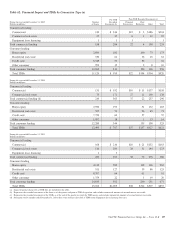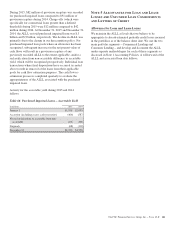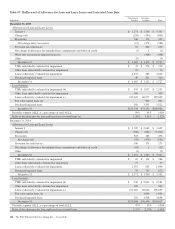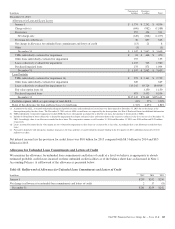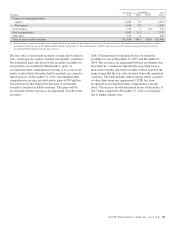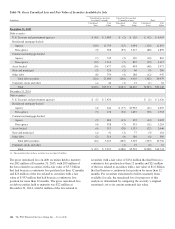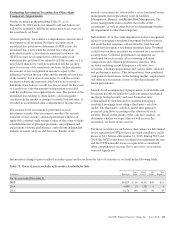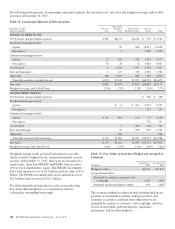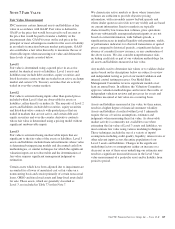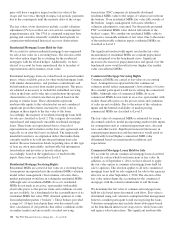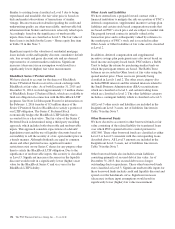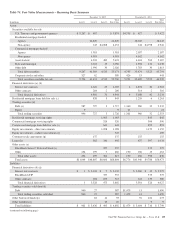PNC Bank 2015 Annual Report Download - page 165
Download and view the complete annual report
Please find page 165 of the 2015 PNC Bank annual report below. You can navigate through the pages in the report by either clicking on the pages listed below, or by using the keyword search tool below to find specific information within the annual report.
Evaluating Investment Securities for Other-than-
Temporary Impairments
For the securities in the preceding Table 70, as of
December 31, 2015 we do not intend to sell and believe we
will not be required to sell the securities prior to recovery of
the amortized cost basis.
At least quarterly, we conduct a comprehensive security-level
assessment on all securities. For those securities in an
unrealized loss position we determine if OTTI exists. An
unrealized loss exists when the current fair value of an
individual security is less than its amortized cost basis. An
OTTI loss must be recognized for a debt security in an
unrealized loss position if we intend to sell the security or it is
more likely than not we will be required to sell the security
prior to recovery of its amortized cost basis. In this situation,
the amount of loss recognized in income is equal to the
difference between the fair value and the amortized cost basis
of the security. Even if we do not expect to sell the security,
we must evaluate the expected cash flows to be received to
determine if we believe a credit loss has occurred. In the event
of a credit loss, only the amount of impairment associated
with the credit loss is recognized in income. The portion of the
unrealized loss relating to other factors, such as liquidity
conditions in the market or changes in market interest rates, is
recorded in accumulated other comprehensive income (loss).
The security-level assessment is performed on each
investment security. Our assessment considers the security
structure, recent security collateral performance metrics if
applicable, external credit ratings, failure of the issuer to make
scheduled interest or principal payments, our judgment and
expectations of future performance, and relevant independent
industry research, analysis and forecasts. Results of the
periodic assessment are reviewed by a cross-functional senior
management team representing Asset & Liability
Management, Finance, and Market Risk Management. The
senior management team considers the results of the
assessments, as well as other factors, in determining whether
the impairment is other-than-temporary.
Substantially all of the credit impairment we have recognized
relates to non-agency residential mortgage-backed securities
and asset-backed securities collateralized by first-lien and
second-lien non-agency residential mortgage loans. Potential
credit losses on these securities are evaluated on a security-by-
security basis. Collateral performance assumptions are
developed for each security after reviewing collateral
composition and collateral performance statistics. This
includes analyzing recent delinquency roll rates, loss
severities, voluntary prepayments and various other collateral
and performance metrics. This information is then combined
with general expectations on the housing market, employment
and other macroeconomic factors to develop estimates of
future performance.
Security level assumptions for prepayments, loan defaults and
loss given default are applied to each non-agency residential
mortgage-backed security and asset-backed security
collateralized by first-lien and second-lien non-agency
residential mortgage loans using a third-party cash flow
model. The third-party cash flow model then generates
projected cash flows according to the structure of each
security. Based on the results of the cash flow analysis, we
determine whether we expect that we will recover the
amortized cost basis of our security.
For those securities on our balance sheet where we determined
losses represented OTTI, we have recorded cumulative credit
losses of $1.1 billion at December 31, 2015. During 2015 and
2014, the OTTI credit losses recognized in noninterest income
and the OTTI noncredit losses recognized in accumulated
other comprehensive income (loss), net of tax, on securities
were not significant.
Information relating to gross realized securities gains and losses from the sales of securities is set forth in the following table.
Table 71: Gains (Losses) on Sales of Securities Available for Sale
In millions Proceeds
Gross
Gains
Gross
Losses
Net
Gains
Tax
Expense
For the year ended December 31
2015 $6,829 $ 56 $(13) $43 $15
2014 4,480 33 (29) 4 1
2013 8,178 146 (47) 99 35
The PNC Financial Services Group, Inc. – Form 10-K 147


